REPRODUCTION IN ANIMALS for Class 8 SCIENCE
Introduction
Jaisa ki hamare chapter ka name hai “Reproduction in animals” toh iss chapter mein hum janege ki animals kaise reproduce karte hai aur apne offsprings ko kaise birth dete hai. Earth par kisi bhi species ke continuation ke liye reproduction necessary hota hai kyonki reproduce kiye bina koi bhi species jyada time tak survive nahi kar paayegi. Jaise kisi bhi organism ke liye digestion, respiration, excreation, etc. sabhi life processess necessary hai waise hi reproduction ka process bhi jaruri hai. Iss chapter mein hum reproduction ke sexual aur asexual dono modes ke baare mein padhenge aur janege ki humans mein reproduction kaise hota hai, gametes kaise produce hote hai, fertlisation kaise hota hai, embryo ka development kaise hota hai, etc. Yaha hum oviparous aur viviparous organisms ke baare mein bhi janege. Last mein hum ek cloned mammal ki story ke baare mein bhi janege.
Reproduction
“Reproduction is the process of producing offsprings that are biologically or genetically similar to the parent organism.”
Modes Of Reproduction
Plants ki tarah animals mein bhi reproduction ke do modes hote hai-Sexual Reproduction
Sexual reproduction mein male aur female dono reproductive organs involve hote hai. Plants ki tarah animals mein bhi reproductive organs se gametes produce hote hai, yeh gametes fuse karke zygote form karte hai. Zygote develop karta hai aur ek new individual ki tarah grow karta hai. Iss type ke reproduction ko sexual reproduction kehte hai.
Ab hum humans ke reproductive organs aur unke process ke baare mein study karenge.
Male Reproductive Organs
Male reproductive organs mein a pair of testes hota hai, do sperm ducts hote hai aur ek penis hota hai. Niche hum male reproductive organ ki picture dekh sakte hai.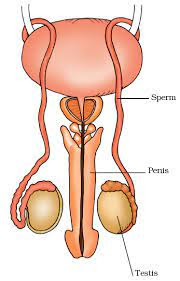
Testes hi male gametes produce karti hai jinko hum sperms kehte hai. Sperms ka size bahut chota hota hai. Sperm ka structure hum niche figure mein dekh sakte hai. Sperm ka ek head hota hai, middle piece hota hai aur tail hoti hai. Yeh single celled hota hai lekin iske andar sabhi usual cell components present hote hai.
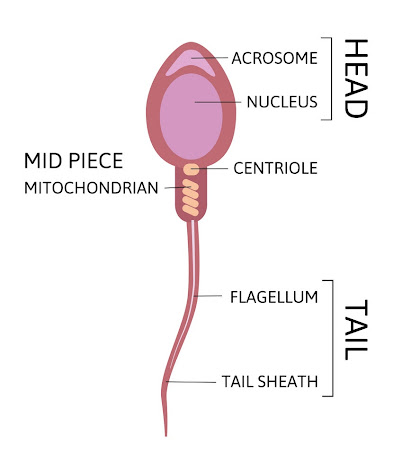
Female Reproductive organs
Female reproductive organs mein a pair of ovaries hoti hai, oviducts hote hai jinko hum fallopian tubes bhi kehte hai aur uterus hota hai. Niche figure mein hum female reproductive organ ka structure dekh sakte hai.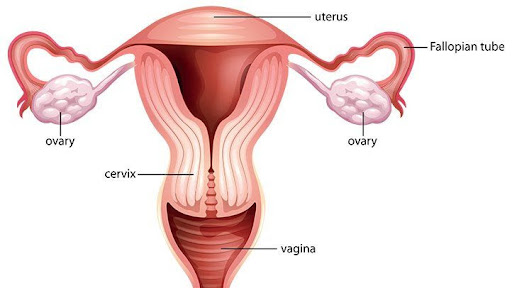
Ovary female eggs produce karti hai, female eggs ko hum ova kehte hai. Egg bhi single celled hota hai. Human beings mein every month ek ovary se ek single matured egg oviduct mein release hota hai. Uterus female reproductive system ka woh part hai jaha baby ka development hota hai. Eggs ka size sabhi organisms mein vary karta hai. Eg- Humans mein egg bahut chota hota hai, hens mein usse bada hota hai aur ostrich egg sabse bada hota hai.

Ab jab yeh male gamete (sperm) aur female gamete (ova) fuse karte hai toh fertilisation hoti hai jiske baare mein hum ab padhenge.
Fertilisation
Jab male ke sperms female ke egg ke contact mein aate hai toh koi ek sperm egg ke saath fuse kar jata hai aur sperm aur egg ke fusion ke issi process ko fertilisation kehte hai.
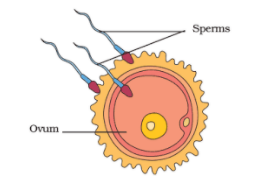
Fertilisation human reproduction ka first step hai. Fertilisation mein sperm aur egg ke nuclei fuse karke ek single nucleus form karte hai. Fertilisation mein egg fertilise hota hai aur zygote formation hota hai.
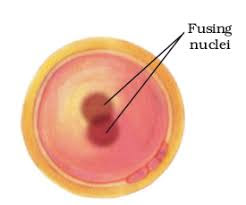
Fertilisation mein mother (female) aur father (male) dono ke gametes fuse karte hai isliye jo new individual form hota hai usme kuchh characteristics father ke hote hai aur kuchh characteristics mother ke hote hai. Eg- Hum apne siblings mein bhi dekh sakte hai aur identify kar sakte hai ki unme kuchh characteristics apne father ki hongi aur kuchh characteristics mother ki hongi.
Fertilisation do types ke hote hai-
Development of Embryo
Jab gametes fuse karte hai toh zygote form hota hai jo develop karke embryo banta hai. Zygote repeatedly divide karta hai aur no. of cells mein rise hota hai. Yeh group of cells mil kar tissue banate hai, tissues se mil kar organs bante hai, organs se organ system banta hai aur iss tarah se new organism form hota hai. Yeh jo developing structure hota hai isko embryo kehte hai. Embryo further development ke liye uterus wall mein embedded hota hai. Jab tak embryo fully develop nahi hota tab tak woh uterus mein hi develop karta hai. Jab embryo ke body parts jaise hands, legs, eyes, head, ears, etc. fully develop ho jate hai, iss stage par hum embryo ke body parts ko properly identify kar pate hai aur iss stage ko hum foetus kehte hai. Jab mother ke womb mein foetus ki development complete ho jati hai toh mother baby ko birth deti hai.
Viviparous and Oviparous Animals
Sabhi organisms eggs lay karte hai, lekin kuchh organisms body ke andar hi egg lay karte hai aur kuchh organisms body se bahar eggs lay karte hai. Iss basis par animals ko do parts mein divide kiya gaya hai.Viviparous animals: Aise animals jo young ones ko birth dete hai unko viviparous animals kehte hai.
Viviparous animals body ke andar hi eggs lay karte hai.
Oviparous animals: Aise animals jo eggs lay karte hai unko oviparous animals kehte hai.
Young Ones to Adults
Aise organisms jo eggs se hatch hote hai woh adult hone tak grow karte rehte hai. Young ones aur adults ki appearance aur characteristics mein bhi difference dekha jata hai.Eg- Silkworm ki lifecycle dekhe toh sabse pehle egg hota hai, egg se larvae ya caterpillar banta hai, caterpillar se pupa banta hai, pupa se adult banta hai.
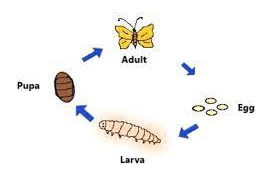
Hum frog ke case mein bhi different stages observe kar sakte hai. Yeh pehle egg hota hai, egg se tadpole banta hai, tadpole se adult banta hai.

Larva ki adult mein transformation ki iss process ko metamorphosis kehte hai.
Asexual Reproduction
Asexual reproduction ek aisa reproduction hai jisme single parent se offspring produce hote hai, isme gamete formation ya fusion bhi nahi hota.
Small animals jaise hydra, amoeba, etc. asexual methods se reproduce karte hai.
Hydra budding se reproduce karta hai. Hydra mein bulges present hote hai jinko hum buds bhi kehte hai. Buds se hi new individual form hote hai.
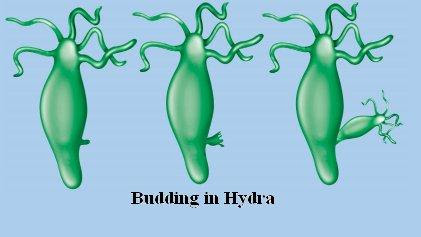
Amoeba ek microscopic organism hai jo asexual method se reproduce karta hai.Yeh binary fission se reproduce karta hai.
Amoeba ek single celled organism hota hai. Reproduction ke time par iska nucleus do nuclei mein convert ho jata hai aur further iski body ka bhi division ho jata hai. Ek parent amoeba se do amoebae produce hote hai. Parent amoeba se do amoebae produce hone ke iss method ko hi binary fission kehte hai.

Binary fission aur budding ke alawa bhi asexual reproduction ke bahut saare methods hote hai, inke baare mein hum higher classes mein detail mein padhenge.
Story of Dolly- the clone
Ab hum ek aisi process ke baare mein padhenge jisme hum kisi cell, living part ya poore organism ki exact copy create kar sakte hai. Iss process ko hum cloning kehte hai.
Cloning- Kisi bhi organism ki exact copy create karne ke process ko hum cloning kehte hai.
Iss process ko first time successfully Ian Wilmut aur unke colleagues ne Roslin institute, Edinburgh, scotland mein perform kiya. Inhone ek Dolly name ki sheep ko successfully clone kiya. 5 july, 1996 ko yeh first mammal ka clone banaya gaya.
Ab hum janege ki iski cloning kaise ki gayi-
Cloning ki process ke liye ek female Finn Dorsett sheep ke mammary gland se ek cell collect kiya gaya aur Scottish blackface ewe se ek egg obtain kiya gaya. Iss egg ka nucleus remove kar diya gaya aur mammary gland wale cell ka nucleus isme place kiya gaya. Ab hamare paas jo egg ready hua usko Scottish blackface ewe mein implant kiya gaya. Iss egg ki normal development hui aur finally Dolly born hui. Dolly ko birth toh Scottish blackface ewe ne diya lekin yeh bilkul Finn Dorsett sheep jaisi thi aur usme Scottish blackface ewe ki koi characteristic nhi tha. Dolly Fin Dorsett sheep ki ek healthy clone thi jisne baad mein normal sexual means se apne kafi offsprings ko birth diya.
14 February, 2003 ko ek certain lung disease ki wajah se Dolly ki death ho gayi.
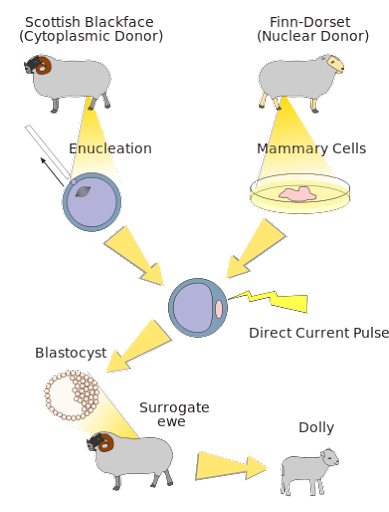
Iske baad clones banane ke liye aur bahut saare attempts kiye gaye lekin kuchh birth se pehle die ho gaye aur kuchh birth ke kuchh time baad. Cloned animals bahut baar banaye gaye aur unme mostly bahut abnormalities paayi gayi.
POINT 1
Reproduction: Reproduction is the process of producing offsprings that are biologically or genetically similar to the parent organism.
Asexual reproduction: Asexual reproduction is a type of reproduction that does not involve the fusion of gametes or change in the number of chromosomes.
Sexual reproduction: Sexual reproduction, the production of new organisms by the combination of genetic information of two individuals of different sexes.
Fertilisation: The process of combining the male gamete, or sperm, with the female gamete, or ovum.
Zygote: The cell formed by the union of the nuclei of two reproductive cells (gametes), especially a fertilized egg cell.
Embryo: An embryo is the early stage of development of a multicellular organism.
Budding: Budding is a type of asexual reproduction in which a new organism develops from an outgrowth or bud due to cell division at one particular site.
Binary fission: Binary fission is a type of asexual reproduction where a parent cell divides, resulting in two identical cells, each having the potential to grow to the size of the original cell.
Internal Fertilisation: Internal fertilization is the process of fertilization that occurs inside the body of an individual.
External Fertilisation: External fertilization is a mode of reproduction in which a male organism's sperm fertilizes a female organism's egg outside of the female's body.
Oviparous animals: An oviparous animal is one that produces eggs, and the young hatch after being expelled from the body.
Viviparous animals: Viviparous animals are those in which fertilization and embryo development occur inside the individual.
SUMMARY
There are two modes by which animals reproduce. These are: (i) Sexual reproduction, and (ii) Asexual reproduction.
Reproduction resulting from the fusion of male and female gametes is called sexual reproduction.
The reproductive organs in the female include ovaries, oviducts and uterus.
The reproductive organs in male include testes, sperm ducts and penis.
The ovary produces female gametes called ova and the testes produce male gametes called sperms.
The fusion of ovum and sperm is called fertilisation. The fertilised egg is called a zygote.
Fertilisation that takes place inside the female body is called internal fertilisation. This is observed in human beings and other animals such as hens, cows and dogs.
Fertilisation that takes place outside the female body is called external fertilisation. This is observed in frogs, fish, starfish, etc.
The zygote divides repeatedly to give rise to an embryo.
The embryo gets embedded in the wall of the uterus for further development.
The stage of the embryo in which all the body parts are identifiable is called foetus.
Animals such as human beings, cows and dogs which give birth to young ones are called viviparous animals.
Animals such as hen, frog, lizard and butterfly which lay eggs are called oviparous animals.
The transformation of the larva into adult through drastic changes is called metamorphosis.
The type of reproduction in which only a single parent is involved is called asexual reproduction.
In hydra, new individuals develop from buds. This method of asexual reproduction is called budding.
Amoeba reproduces by dividing itself into two. This type of asexual reproduction is called binary fission.
